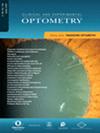太阳镜滤光片对间歇性外斜视患者对比敏感度、单眼闭合和眨眼率的影响。
IF 1.7
4区 医学
Q3 OPHTHALMOLOGY
引用次数: 0
摘要
临床意义据报道,间歇性外斜视(IXT)患者在强光下会出现短暂的单眼闭合和光敏现象。本研究探讨了太阳镜滤光片对 IXT 患者在强光下的对比敏感度(CS)、瞬时单眼闭合和眨眼率的影响。在有眩光和无眩光的中视和近视条件下,以及在使用和不使用两种不同透光率的滤光镜(滤光镜 1:透光率 44-80%;滤光镜 2:透光率 20-43%)的条件下,进行双眼 CS 测试。在强光下,评估了两种滤光镜对瞬时闭眼、对比敏感度和眨眼率的影响。结果参与者的平均年龄为 12.0 岁 ± 8.0(标准差)(范围:7-40 岁)。三个融合控制组的年龄(p = 0.139)、立体视(p = 0.134)以及远近偏差程度(p = 0.516 和 p = 0.237)均无明显差异。在有眩光的中视条件下,使用滤光镜时的平均双眼CS明显更高(p < 0.001)。在不使用滤光片的情况下,57.5% 的受试者在有额外眩光的近视环境下表现出单眼闭合。使用滤光片 2 时,没有人出现闭眼现象。不良对照组中,有 62.5%的人在单眼闭合前出现眨眼现象(不使用滤光镜时为 62.5%,使用滤光镜 1 时为 12.5%,P = 0.01)。眨眼次数从未戴滤光镜时的 36.0 ± 4.0 次/分钟减少到戴滤光镜 1 时的 21.0 ± 3.0 次/分钟,戴滤光镜 2 时的 20.0 ± 3.0 次/分钟。为改善这些症状,IXT 患者可考虑佩戴太阳镜。本文章由计算机程序翻译,如有差异,请以英文原文为准。
The effect of sunglass filters on contrast sensitivity, monocular eye closure, and blinking rate in people with intermittent exotropia.
CLINICAL RELEVANCE
Transient monocular eye closure and photosensitivity under bright light have been reported in people with intermittent exotropia (IXT). The exact mechanism of these symptoms has not been established.
BACKGROUND
This study examines the effect of sunglass filters on contrast sensitivity (CS), transient monocular eye closure, and blinking rate under bright light in people with IXT.
METHODS
Forty participants with IXT and complaints of photosensitivity were included in the study. The binocular CS test was performed under mesopic and photopic conditions with and without glare, and with and without two filters with different grades of light transmission (filter 1: 44-80%; filter 2: 20-43% light transmittance). The effect of two filters on transient eye closure, contrast sensitivity, and blinking rate was assessed under bright light. Also, participants were divided into 3 groups based on their degree of control of fusion (good, fair, and poor control).
RESULTS
The mean age of the participants was 12.0 years ± 8.0 (standard deviation) (range: 7-40 years). There was no significant difference between the age (p = 0.139), stereopsis (p = 0.134), as well as the near and far degree of deviation (p = 0.516, and p = 0.237) between the three groups of fusion control. Under mesopic conditions with glare, mean binocular CS was significantly higher with filters (p < 0.001). Without filters, 57.5% of the participants exhibited monocular eye closure under a photopic setting with additional glare. No participant showed eye closure using filter 2. People in the poor control group showed exodeviation before monocular eye closure (62.5% without filter and 12.5% with filter 1, p = 0.01). The blinking rate decreased from 36.0 ± 4.0 blinks per minute without filter to 21.0 ± 3.0 using filter 1, and 20.0 ± 3.0 with filter 2.
CONCLUSION
In people with IXT, wearing sunglass filters of different transmittance reduces monocular eye closure and blinking rate under bright light. To improve these symptoms, sunglasses can be considered for IXT.
求助全文
通过发布文献求助,成功后即可免费获取论文全文。
去求助
来源期刊
CiteScore
4.10
自引率
5.30%
发文量
132
审稿时长
6-12 weeks
期刊介绍:
Clinical and Experimental Optometry is a peer reviewed journal listed by ISI and abstracted by PubMed, Web of Science, Scopus, Science Citation Index and Current Contents. It publishes original research papers and reviews in clinical optometry and vision science. Debate and discussion of controversial scientific and clinical issues is encouraged and letters to the Editor and short communications expressing points of view on matters within the Journal''s areas of interest are welcome. The Journal is published six times annually.

 求助内容:
求助内容: 应助结果提醒方式:
应助结果提醒方式:


